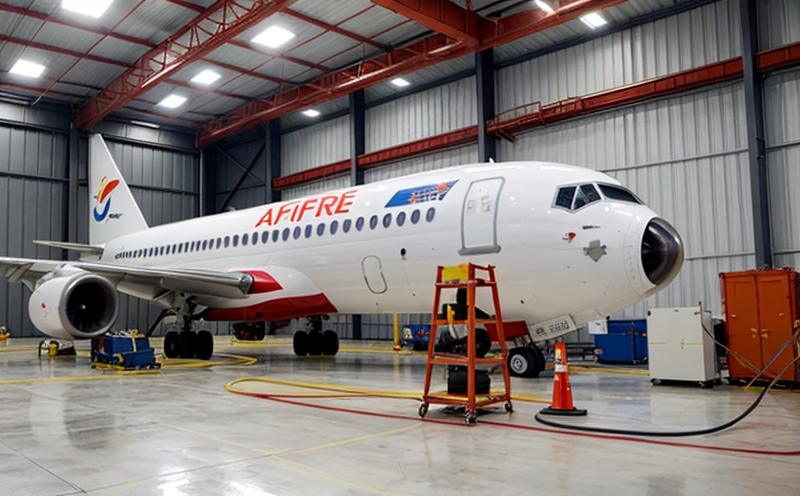Fire Resistance Testing of Aircraft Floor Coverings
The aerospace industry places a premium on safety and reliability. One critical aspect of this is ensuring that materials used in aircraft interiors, including floor coverings, meet stringent fire resistance standards. This ensures that in the event of an onboard fire, passengers and crew have a greater chance of survival.
Fire resistance testing involves subjecting samples to controlled laboratory conditions designed to simulate real-world scenarios where flames or high temperatures are present. The objective is to evaluate how well these materials withstand exposure to such hazards without igniting easily or releasing toxic fumes that could exacerbate the situation.
Aircraft floor coverings must comply with regulations set forth by organizations like the International Civil Aviation Organization (ICAO) and the Federal Aviation Administration (FAA). These standards are designed not only to protect passengers but also to minimize the risk of fire spreading throughout the aircraft cabin. Compliance ensures that airlines meet safety requirements for certification.
The testing process typically involves placing a specimen on a specially designed test rig where it is exposed to controlled flames or heat sources. The duration and intensity of these exposures can vary depending on specific standards being targeted, such as those outlined in ASTM E648-19 or IEC 60332.
During testing, engineers closely monitor various parameters including flame spread rates, smoke density levels, and material integrity. After the test concludes, detailed reports are generated outlining performance metrics against relevant benchmarks. This information helps manufacturers refine their products further enhancing overall safety standards across the industry.
It's important to note that fire resistance testing is just one component of a broader quality assurance program aimed at ensuring the highest level of product integrity and reliability in aerospace applications. By adhering strictly to prescribed protocols, labs like ours contribute significantly towards maintaining public trust while complying with international best practices.
Why It Matters
The importance of fire resistance testing cannot be overstated when it comes to aircraft floor coverings. In the event of an onboard fire, every second counts. Materials that do not perform adequately could quickly ignite and spread flames across the cabin, potentially causing severe injuries or fatalities.
- Passenger Safety: Ensuring materials meet rigorous fire resistance standards significantly enhances passenger safety by reducing the risk of injury due to rapid escalation of incidents involving smoke inhalation or burns.
- Economic Impact: Non-compliance with industry regulations can lead to costly delays in certification processes, recalls, and potential legal liabilities for manufacturers. Meeting these requirements upfront saves time and money throughout product development cycles.
- Environmental Considerations: Flame retardant treatments used during testing help prevent the release of harmful pollutants into the atmosphere if a fire were to occur onboard an aircraft. This aligns with broader efforts towards more sustainable practices within manufacturing industries globally.
In summary, conducting thorough fire resistance tests on aircraft floor coverings is essential for safeguarding human life and protecting valuable assets against catastrophic failures that could arise from inadequate material choices.
Quality and Reliability Assurance
- Compliance: Our laboratory adheres strictly to international standards such as ASTM E648-19 and IEC 60332, ensuring that all tests conducted are accurate and reliable. These guidelines provide clear criteria against which materials can be evaluated.
- Expertise: With years of experience in aerospace testing, our team brings unparalleled expertise to each project. Our engineers understand the unique challenges faced by manufacturers when selecting appropriate fire resistant floor coverings for use within aircraft interiors.
We employ state-of-the-art equipment capable of replicating real-world conditions under which materials are expected to perform reliably. From precise temperature control systems to advanced optical sensors, our facilities offer an environment where thorough evaluation can take place without compromising accuracy or consistency.
Upon completion of testing, comprehensive reports detailing results are provided along with recommendations for any necessary modifications based on findings. This feedback loop allows manufacturers to continually improve their products, ultimately leading to safer aircraft designs and operations.
Customer Impact and Satisfaction
- Peace of Mind: Knowing that rigorous testing has been performed reassures customers about the safety features incorporated into new or modified aircraft models. This trust fosters long-term relationships between suppliers and purchasers alike.
- Informed Decision-Making: By leveraging detailed test data from reputable laboratories like ours, clients can make informed decisions regarding material selection knowing full well that they are choosing products proven to meet industry benchmarks.
We strive to exceed expectations by delivering accurate, timely results accompanied by expert analysis. Our commitment to customer satisfaction is reflected in our transparent communication throughout the testing process and beyond, ensuring complete transparency about every aspect of your project.





